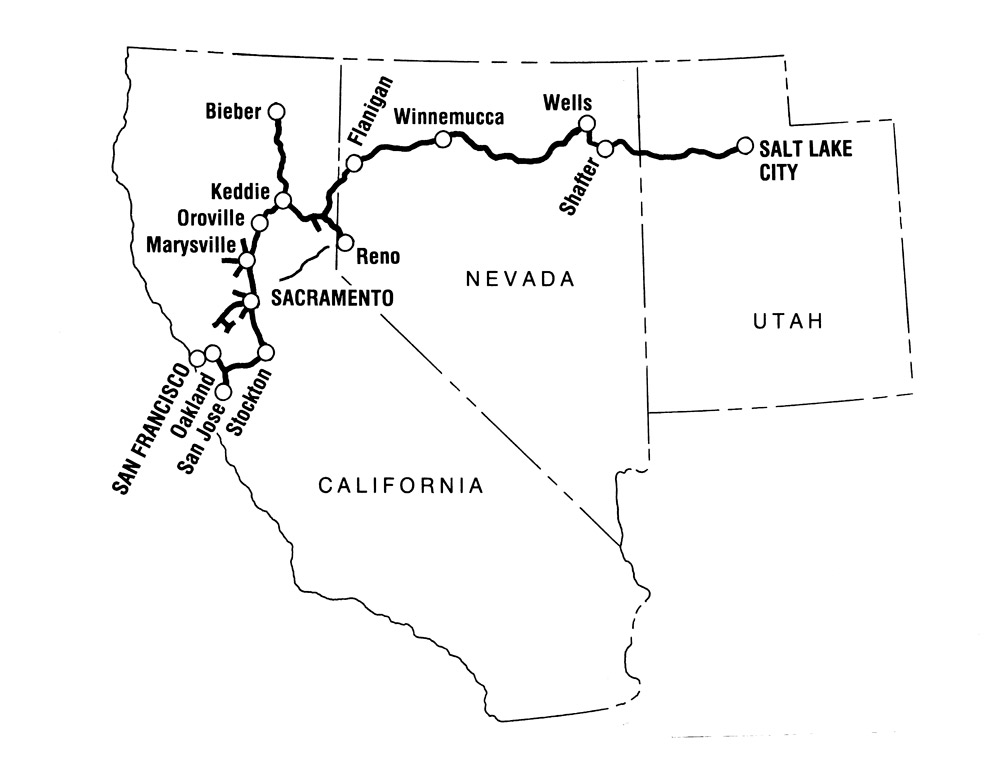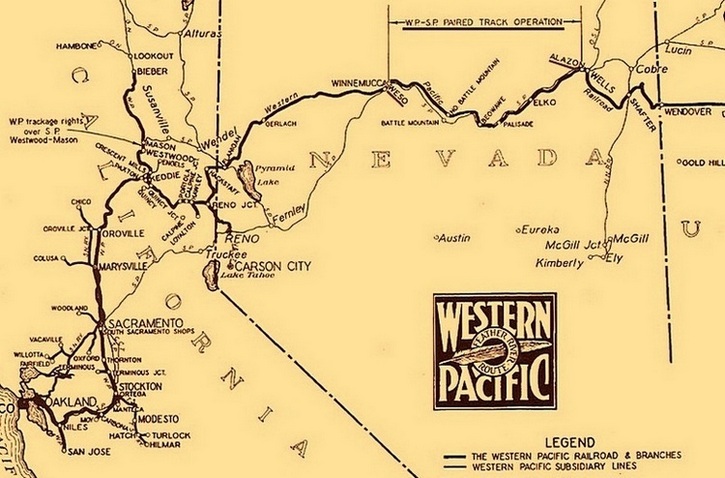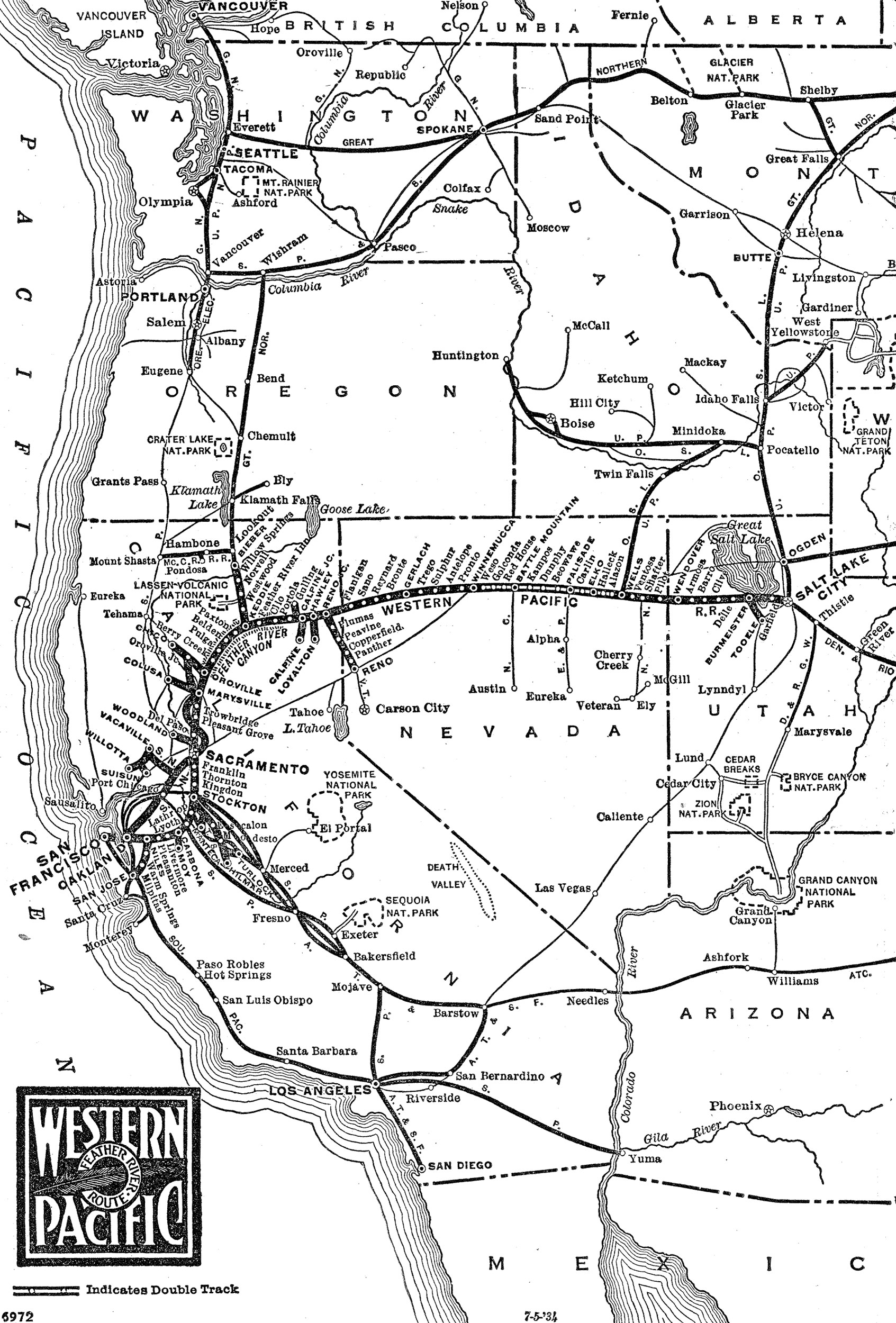Western Pacific Railroad Map: Western Pacific Railroad Route
The western pacific railroad map is a detailed and intricate map of the railroad that lies west of the Rocky Mountains. This map is perfect for anyone interested in railroad history or in simply studying the route of this historic railway.
The map itself is quite large, measuring in at 39 inches by 31 inches, and is filled with all sorts of interesting information about the western pacific railroad. If you’re looking for a detailed and informative map of this railroad, then look no further than the western pacific railroad map!

A Brief Overview of the Western Pacific’s History
The Western Pacific Railroad was chartered in 1865 to build a transcontinental railroad from the eastern United States to California.
The original route of the Western Pacific passed through the Sierra Nevada mountains, which presented a major challenge for construction.
In 1867, the Central Pacific Railroad (CPRR) reached an agreement with the Union Pacific Railroad (UPRR) to build a joint line west of Omaha, Nebraska.
This led to the eventual completion of the first transcontinental railroad in 1869.
The Western Pacific was acquired by the CPRR in 1870 and became part of the Southern Pacific Company (SP) in 1885.
The SP operated the WP until 1970 when it was merged into the SP’s new subsidiary, the Cotton Belt Railroad.
In 1997, the WP was acquired by Union Pacific.
The Western Pacific’s construction history is closely tied to the Sierra Nevada mountain range that it had to cross in order to reach California.
During the 1870s and 1880s, it was forced to reroute several times due to disagreements with CPRR over costs of construction.
In 1886, company head Charles Crocker began building a line through Gold Run on his own initiative, despite an agreement with SP not to do so until other routes were exhausted.
This move led SP president E. H. Harriman and the CPRR board of directors to place Crocker under arrest for insubordination, but he was later released after receiving apologies from both parties.[1]
The Western Pacific’s construction difficulties were not resolved until the late 1880s. SP president Harriman pushed through the last stages of construction between 1907 and 1909, with the line finally reaching northern California in 1909.
In terms of speed, the Western Pacific was considered one of America’s premier railroads during this period.
It reached Salt Lake City by 1912 and set its first record for the fastest train trip from Oakland to Salt Lake City, making the 1,450-mile journey in just over 16 hours.
The railroad also won accolades for servicing its passenger trains with high-quality accommodations and dining cars.

Western Pacific Passenger Trains of Notable Merit
The Western Pacific was known for its passenger trains, particularly the “Zephyr” and “Empire Builder”, which were considered two of the best in America.
As a subsidiary of SP in 1926, the railroad launched its first notable passenger train, the “California Zephyr.”
The transcontinental line offered luxurious service with dome cars, parlor cars, and sleeping accommodations.
In 1949, it became a joint venture between WP and Chicago & North Western Railway (CNW).
The following year, it expanded to include Burlington Lines and the Denver & Rio Grande Western Railroad (D&RGW), becoming known as the “Silver Lady.”
After Burlington Northern acquired CNW in 1995, all three lines merged to become the Union Pacific/Burlington Northern and Santa Fe Railway (BNSF) “Empire Builder,” which has been recognized as one of America’s finest passenger trains.
Today, the Western Pacific continues to provide high-quality rail service across its 1,950-mile network from Salt Lake City to Oakland, California.
It is a vital link for cargo shipping throughout the western United States and Canada.
Although it no longer operates any notable passenger trains, its freight business continues to thrive in a highly competitive market.

A roster of Diesel-Powered Locomotives
The Western Pacific’s diesel locomotive roster was dominated by EMD products, with the exception of a few early diesel from other manufacturers.
The railroad’s first diesel locomotive was an Alco RS-1, which was delivered in 1941 and used on light duties.
The WP eventually acquired more than 200 RS-1s and their variants, the last of which were retired in 1978.
Other early diesel included GP7s, GP9s, and F7s.
The bulk of the WP’s diesel fleet consisted of SD40s and SD40-2s, which were acquired between 1966 and 1979.
The last new locomotives purchased by the WP were SD50s, which were made by EMD and delivered in 1987.
The Western Pacific’s diesel locomotive roster was dominated by EMD products with the exception of a few early diesels from other manufacturers.
The railroad’s first diesel locomotive was an Alco RS-1 that it acquired in 1941.
These lightweight units were used on lighter duties before being replaced in 1955 by much larger and more powerful GP7s, GP9s, and F7s.
By the 1960s, WP had upgraded its fleet to include several hundred SD40s and SD40-2s that were ordered between 1966 and 1979.
In 1987, the railroad purchased 10 new SD50 locomotives from EMD to replace older units that were being retired.
Although the WP no longer operates any passenger trains, its freight business continues to thrive in a highly competitive market.
In 2019, the railroad was acquired by Union Pacific.

The American Locomotive Company is a railroad company based in the United States.
| Model Type | Road Number | Date Built | Quantity/Notes |
|---|---|---|---|
| S1 | 504-511 | 5/1942-6/1942 | 8 |
| S2 | 551-562 | 9/1943-3/1950 | 12 |
| S2 | 552 (2nd) | 5/1949 | 1 (Built as Missouri Pacific #9129. Acquired on 2/12/1970. |
| S2 | 554 (2nd) | 3/1948 | 1 (Built as Texas Pacific-Missouri Pacific Terminal #12. Acquired on 7/7/1969.) |
| S4 | 563-564 | 6/1951 | 2 |
Baldwin Locomotive Works is a locomotive manufacturing company in Baldwin, Ohio.
| Model Type | Road Number | Date Built | Quantity |
|---|---|---|---|
| VO-1000 | 581-585 | 10/1945-11/1945 | 5 |
Budd Corporation is a privately held corporation based in Budd, New Hampshire.
| Model Type | Road Number | Date Built | Quantity |
|---|---|---|---|
| RDC-2 | 375-376 | 9/15/1950 | 2 (Named “Zephyrettes”) |
Electro-Motive Corporation/Electro-Motive Division is an American corporation that manufactures electric motors.
| Model Type | Road Number (Original) | Road Number (2nd/3rd) | Date Built | Quantity/Notes |
|---|---|---|---|---|
| SW1 | 501-503 | – | 8/1939-12/1939 | 3 (#501 built as demonstrator #906) |
| SW9 | 601-606 | – | 5/1952-7/1952 | 6 |
| NW2 | 607-608 | – | 10/1939, 5/1940 | 2 (Built as Union Pacific #1000-1001. Became Stockton Terminal & Eastern #1000-1001 in 8/1966. #1000 began life as demonstrator #889.) |
| GP7 | 701-713 | – | 10/1952-4/1953 | 13 |
| GP9 | 725-732 | – | 9/1955 | 8 |
| F3A | 801A | 925A (7/8/1968) | 6/1947 | 1 |
| F3A | 802A | 925D (7/5/1968) | 6/1947 | 1 |
| F3A | 803A | – | 6/1947 | 1 |
| F3A | 801D | 926A (7/1968) | 3/1948 | 1 (Built as New York, Ontario & Western #503.) |
| F3B | 801B-803B, 801C-803C | – | 6/1947 | 6 |
| FP7 | 804A | – | 1/1950 | 1 |
| FP7 | 805A | – | 1/1950 | 1 |
| FP7 | 804C | 804D (4/11/1951)/916D (2nd, 4/14/1970) | 1/1950 | 1 |
| FP7 | 805C | 805D (4/11/1951) | 1/1950 | 1 |
| FTA | 901-912, 901C-912C | 901A/D-912A/D | 11/1941-1/1944 | 24 |
| FTB | 901A-912A, 901B-912B | 901B/C-912B/C | 11/1941-1944 | 24 |
| F7A* | 913A-924A, 913D-924D | – | 1/1950-6/1951 | 24 |
| F7B* | 804B-805B, 913B-924B, 913C-924C | – | 1/1950-6/1951 | 26 |
| SW1500 | 1501-1503 | – | 6/1973 | 3 |
| GP20 | 2001-2010 | – | 11/1959-7/1960 | 10 |
| GP35 | 3001-3022 | – | 11/1963-4/1965 | 22 |
| GP40 | 3501-3544 | – | 5/1966-9/1971 | 44 |
| GP40-2 | 3545-3559 | – | 7/1979-4/1980 | 15 |
GE (General Electric Company)
| Model Type | Road Number (Original) | Road Number (2nd) | Date Built | Quantity |
|---|---|---|---|---|
| U30B | 751-769 | 3051-3069 | 1/1967-9/1968 | 19 |
| U30B | 770-771 | 3070-3071 | 6/1966 | 2 (Built as demonstrators #303-304.) |
| U23B | 2251-2265 | – | 5/1972-6/1972 | 15 |
Roster of Steam Locomotives
| Road Number(s) | Class | Arrangement | Builder | Date Built |
|---|---|---|---|---|
| 1-20 | C-43 | 2-8-0 | Baldwin | 9/1906-11/1906 |
| 21-65 | C-43 | 2-8-0 | Alco | 1909 |
| 71-106 | TP-29 | 4-6-0 | Alco/Brooks | 1908-1909 |
| 121-122 | TF-17 | 4-6-0 | Richmond | 1896 (Ex-Alameda & San Joaquin) |
| 123 | 2-6-0 | Baldwin | 5/1876 (Ex-Boca & Loyalton) | |
| 124 | 2-8-0 | Baldwin | 2/1882 (Ex-B&L) | |
| 125 | 4-6-0 | Pittsburgh | 7/1888 (Ex-B&L) | |
| 125-127 | 4-6-0 | Rome | 1/1891 (Ex-Denver & Rio Grande) | |
| 151-162 | 0-6-0 | Alco | 1909 | |
| 163-166 | 0-6-0 | Alco | 7/1915-12/1919 (Ex-Verde Tunnel) | |
| 171-180 | 4-8-2 | Alco | 1924 (Ex-Florida East Coast) | |
| 201-205 | 2-6-6-2 | Alco/Brooks | 1917 | |
| 206-210 | 2-6-6-2 | Alco/Richmond | 4/1924-5/1924 | |
| 251-260 | 2-8-8-2 | Baldwin | 5/1931-3/1938 | |
| 301-305 | 2-8-2 | Alco/Brooks | 1918 | |
| 306-310 | 2-8-2 | Alco | 6/1919 | |
| 311-326 | 2-8-2 | Alco/Brooks | 1921-1924 | |
| 321-325 (2nd)* | 2-8-2 | Baldwin | 1919 | |
| 327-336 | 2-8-2 | Alco | 1926-1929 | |
| 401-407 | 4-6-6-4 | Alco | 1938 | |
| 481-486 | 4-8-4 | Lima | 6/19 |
History of the Western Pacific Railroad Construction from both east and west
The Western Pacific Railroad was constructed in the late 19th century to connect California with the rest of the United States. The railroad ran from Oakland, California to Salt Lake City, Utah. Construction of the railroad began in 1864 and was completed in 1869.
The Western Pacific Railroad was originally built as a transcontinental railroad, but it was eventually sold to the Central Pacific Railroad. The Central Pacific Railroad then extended the line eastward to Promontory Summit, where it met with the Union Pacific Railroad.
The Western Pacific Railroad played an important role in the development of California and the American West. The railroad helped to open up new markets for California products and made it possible for people and goods to travel between the East and West Coasts.
Today, the Western Pacific Railroad is operated by the Union Pacific Railroad. The Union Pacific Railroad has continued to invest in the line and has made improvements to infrastructure and equipment. The Western Pacific Railroad is an important part of the Union Pacific Railroad’s transcontinental network.

The evolution of the Western Pacific Railroad during World War II
Western Pacific Railroad is also an interesting topic. During the war, the railroad served as a major transportation route for troops and military vehicles traveling between California and the East Coast. In addition, the Western Pacific Railroad was involved in extensive wartime construction projects throughout the western United States.
Despite its important role in American history, however, little is known about the Western Pacific Railroad today. Many people are unaware of this historic railroad or its contribution to westward expansion and economic development. There is still much that can be learned about this fascinating part of America’s railway network.
The history of the Western Pacific Railroad is a fascinating story that encompasses both triumphs and challenges over more than 150 years of operation. From its origins as a transcontinental railroad to its continued importance today as part of the Union Pacific Railroad’s transcontinental network, the Western Pacific Railroad has played a significant role in the development of the American West. Although it is not as well-known as some of America’s other historic railroads, the Western Pacific Railroad remains an important part of our nation’s railway history.

Currently working on the WP
The Western Pacific Railroad was a major transportation route for people and goods traveling between California and the rest of the United States in the late 19th century. Construction of the railroad began in 1864, and it was completed in 1869.
During World War II, the Western Pacific Railroad played an important role in providing transportation for troops and military vehicles between California and the East Coast. In addition, it was involved in many wartime construction projects throughout the western United States.
Although it is not as well-known as some other historic railroads, the Western Pacific Railroad remains an important part of America’s railway history. From its origins as a transcontinental railroad to its continued importance today, this historic railroad has helped shape the development of the American West.
F.A.Q talk about Western Pacific Railroad Map:
How long has the Western Pacific Railroad been in operation?
As a consequence, the 924-mile line built by WP is still in operation today under the ownership of Union Pacific. Though tiny in size, the Western Pacific is notable for a number of accomplishments, including running one of the most successful streamliners in history, building the famed Keddie Wye, and maintaining the critical “Inside Gateway.”
What is the location of the Western Pacific Railroad?
California’s Western Pacific Railroad (1862-1870) was established in 1862 with the goal of building a railway between Sacramento and San Francisco Bay, which would serve as the westernmost segment of the First Transcontinental Railroad.
What states did the Pacific Railroad pass through on its way to California?
Settlers that traveled on the Union Pacific Railroad were most often from the eastern or midwestern states that bordered the railroad’s tracks and connections, such as Illinois, Iowa, Missouri, Nebraska, Wyoming, and Utah, as well as other states in the region. The majority of them would have chosen to settle in Utah, Nevada, or northern California.
Conclusion:
The western pacific railroad map is a great way to see the progress of the railroad and where it is headed. If you are interested in history, geography, or trains, this map is definitely for you.
Thanks for following along on our journey through the development of the western pacific railroad!
And this article Westernencounters.com will help you answer questions about Western Pacific Railroad Map:
- feather river canyon railroad map
- union pacific railroad map
- southern pacific railroad map
- western pacific railroad route
- western pacific railroad feather river route
- western pacific railroad steam locomotives
- western pacific railroad museum
- western pacific california zephyr























